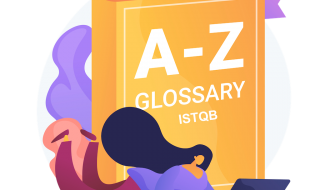💚 Bài viết này giới thiệu nội dung đề cương ISTQB CTFL mới nhất ISTQB® 4.0 được phát hành vào ngày 09.05.2023. Bạn có thể xem nội dung đề cương online hoặc tải về ISTQB® 4.0 theo đường dẫn bên dưới.
Nội Dung Đề Cương Syllabus ISTQB® 4.0 (2023)
Xem nội dung istqb online
- Fundamentals of Testing – 180 minutes
1.1. What is Testing?
1.1.1. Test Objectives
1.1.2. Testing and Debugging
1.2. Why is Testing Necessary?
1.2.1. Testing’s Contributions to Success
1.2.2. Testing and Quality Assurance (QA)
1.2.3. Errors, Defects, Failures, and Root Causes
1.3. Testing Principles
1.4. Test Activities, Testware and Test Roles
1.4.1. Test Activities and Tasks
1.4.2. Test Process in Context
1.4.3. Testware
1.4.4. Traceability between the Test Basis and Testware
1.4.5. Roles in Testing
1.5. Essential Skills and Good Practices in Testing
1.5.1. Generic Skills Required for Testing
1.5.2. Whole Team Approach
1.5.3. Independence of Testing - Testing Throughout the Software Development Lifecycle – 130 minutes
2.1. Testing in the Context of a Software Development Lifecycle
2.1.1. Impact of the Software Development Lifecycle on Testing
2.1.2. Software Development Lifecycle and Good Testing Practices
2.1.3. Testing as a Driver for Software Development
2.1.4. DevOps and Testing
2.1.5. Shift-Left Approach
2.1.6. Retrospectives and Process Improvement
2.2. Test Levels and Test Types
2.2.1. Test Levels
2.2.2. Test Types
2.2.3. Confirmation Testing and Regression Testing
2.3. Maintenance Testing - Static Testing – 80 minutes
3.1. Static Testing Basics
3.1.1. Work Products Examinable by Static Testing
3.1.2. Value of Static Testing
3.1.3. Differences between Static Testing and Dynamic Testing
3.2. Feedback and Review Process
3.2.1. Benefits of Early and Frequent Stakeholder Feedback
3.2.2. Review Process Activities
3.2.3. Roles and Responsibilities in Reviews
3.2.4. Review Types
3.2.5. Success Factors for Reviews - Test Analysis and Design – 390 minutes
4.1. Test Techniques Overview
4.2. Black-Box Test Techniques
4.2.1. Equivalence Partitioning
4.2.2. Boundary Value Analysis
4.2.3. Decision Table Testing
4.2.4. State Transition Testing
4.3. White-Box Test Techniques
4.3.1. Statement Testing and Statement Coverage
4.3.2. Branch Testing and Branch Coverage
4.3.3. The Value of White-box Testing
4.4. Experience-based Test Techniques
4.4.1. Error Guessing
4.4.2. Exploratory Testing
4.4.3. Checklist-Based Testing
4.5. Collaboration-based Test Approaches
4.5.1. Collaborative User Story Writing
4.5.2. Acceptance Criteria
4.5.3. Acceptance Test-driven Development (ATDD) - Managing the Test Activities – 335 minutes
5.1. Test Planning
5.1.1. Purpose and Content of a Test Plan
5.1.2. Tester’s Contribution to Iteration and Release Planning
5.1.3. Entry Criteria and Exit Criteria
5.1.4. Estimation Techniques
5.1.5. Test Case Prioritization
5.1.6. Test Pyramid
5.1.7. Testing Quadrants
5.2. Risk Management
5.2.1. Risk Definition and Risk Attributes
5.2.2. Project Risks and Product Risks
5.2.3. Product Risk Analysis
5.2.4. Product Risk Control
5.3. Test Monitoring, Test Control and Test Completion
5.3.1. Metrics used in Testing
5.3.2. Purpose, Content and Audience for Test Reports
5.3.3. Communicating the Status of Testing
5.4. Configuration Management
5.5. Defect Management - Test Tools – 20 minutes
6.1. Tool Support for Testing
6.2. Benefits and Risks of Test Automation
🍀🍀🍀 Tài liệu cũ hơn
Đề cương ISTQB 2018 V3.1. Kéo xuống bên dưới để xem nội dung đề cương trực tuyến – syllabus 2018 online hoặc tải về ở đây Syllabus ISTQB 2018.
Nội Dung Đề Cương Syllabus ISTQB 2018
1. Fundamentals of Testing
- 1.1 What is Testing?
- 1.1.1 Typical Objectives of Testing
- 1.1.2 Testing and Debugging
- 1.2 Why is Testing Necessary?
- 1.2.1 Testing’s Contributions to Success
- 1.2.2 Quality Assurance and Testing
- 1.2.3 Errors, Defects, and Failures
- 1.2.4 Defects, Root Causes and Effects
- 1.3 Seven Testing Principles
- 1.4 Test Process
- 1.4.1 Test Process in Context
- 1.4.2 Test Activities and Tasks
- 1.4.3 Test Work Products
- 1.4.4 Traceability between the Test Basis and Test Work Products
- 1.5 The Psychology of Testing
- 1.5.1 Human Psychology and Testing
- 1.5.2 Tester’s and Developer’s Mindsets
2. Testing Throughout the Software Development Lifecycle
- 2.1 Software Development Lifecycle Models
- 2.1.1 Software Development and Software Testing
- 2.1.2 Software Development Lifecycle Models in Context
- 2.2 Test Levels
- 2.2.1 Component Testing
- 2.2.2 Integration Testing
- 2.2.3 System Testing
- 2.2.4 Acceptance Testing
- 2.3 Test Types
- 2.3.1 Functional Testing
- 2.3.2 Non-functional Testing
- 2.3.3 White-box Testing
- 2.3.4 Change-related Testing
- 2.3.5 Test Types and Test Levels
- 2.4 Maintenance Testing
- 2.4.1 Triggers for Maintenance
- 2.4.2 Impact Analysis for Maintenance
3. Static Testing
- 3.1 Static Testing Basics
- 3.1.1 Work Products that Can Be Examined by Static Testing
- 3.1.2 Benefits of Static Testing
- 3.1.3 Differences between Static and Dynamic Testing
- 3.2 Review Process
- 3.2.1 Work Product Review Process
- 3.2.2 Roles and responsibilities in a formal review
- 3.2.3 Review Types
- 3.2.4 Applying Review Techniques
- 3.2.5 Success Factors for Reviews
4. Test Techniques
- 4.1 Categories of Test Techniques
- 4.1.1 Categories of Test Techniques and Their Characteristics
- 4.2 Black-box Test Techniques
- 4.2.1 Equivalence Partitioning
- 4.2.2 Boundary Value Analysis
- 4.2.3 Decision Table Testing
- 4.2.4 State Transition Testing
- 4.2.5 Use Case Testing
- 4.3 White-box Test Techniques
- 4.3.1 Statement Testing and Coverage
- 4.3.2 Decision Testing and Coverage
- 4.3.3 The Value of Statement and Decision Testing
- 4.4 Experience-based Test Techniques
- 4.4.1 Error Guessing
- 4.4.2 Exploratory Testing
- 4.4.3 Checklist-based Testing
5. Test Management
- 5.1 Test Organization
- 5.1.1 Independent Testing
- 5.1.2 Tasks of a Test Manager and Tester
- 5.2 Test Planning and Estimation
- 5.2.1 Purpose and Content of a Test Plan
- 5.2.2 Test Strategy and Test Approach
- 5.2.3 Entry Criteria and Exit Criteria (Definition of Ready and Definition of Done)
- 5.2.4 Test Execution Schedule
- 5.2.5 Factors Influencing the Test Effort
- 5.2.6 Test Estimation Techniques
- 5.3 Test Monitoring and Control
- 5.3.1 Metrics Used in Testing
- 5.3.2 Purposes, Contents, and Audiences for Test Reports
- 5.4 Configuration Management
- 5.5 Risks and Testing
- 5.5.1 Definition of Risk
- 5.5.2 Product and Project Risks
- 5.5.3 Risk-based Testing and Product Quality
- 5.6 Defect Management
6. Tool Support for Testing
- 6.1 Test Tool Considerations
- 6.1.1 Test Tool Classification
- 6.1.2 Benefits and Risks of Test Automation
- 6.1.3 Special Considerations for Test Execution and Test Management Tools
- 6.2 Effective Use of Tools
- 6.2.1 Main Principles for Tool Selection
- 6.2.2 Pilot Projects for Introducing a Tool into an Organization
- 6.2.3 Success Factors for Tools
Xem Online Đề Cương ISTQB 2018
Hoặc bạn có thể tải về từ trang gốc https://www.istqb.org/downloads




4 Comments
Leave a reply →